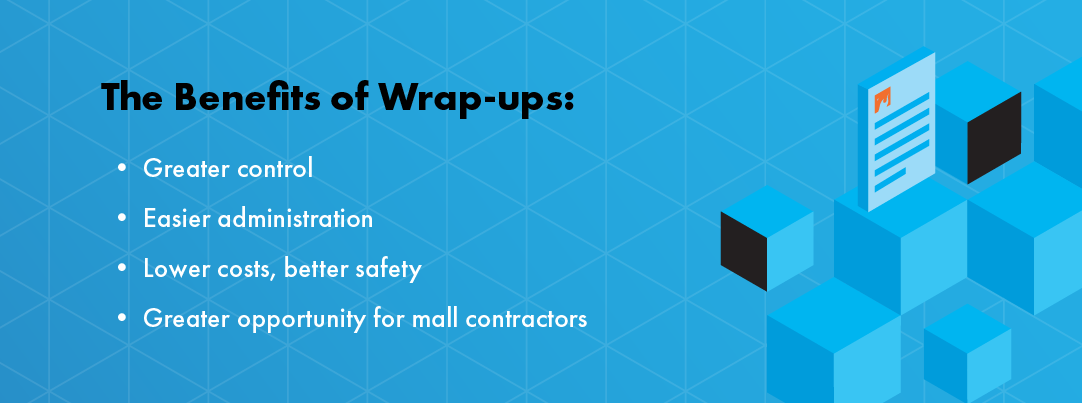Benefits of a Wrap-up Program in Construction Projects
Nobody wants to add 6% more to their total project price because their insurance and wrap-up programs aren’t adequate! In this blog post, we outline the benefits of wrap-up programs for your projects and what to be aware of to assure your projects are adequately covered.
Owner-controlled insurance programs (OCIPs), also known as a “wrap-up program” is a well-managed controlled or consolidated insurance programs usually placed and managed by the project owner. On the other hand, contractor-controlled insurance programs (CCIPs) are governed by the project’s main contractor. Large commercial and residential projects are usually insured through the “wrap-up” phase. This means they combine or wrap up the entire coverage needed for the project into one insurance program. A perfectly designed wrap-up program gives the enrolled parties more conveniences and savings, which makes up for the usual insurance markup in their bids.
Before, project wrap-ups used to cost $100 million or more, but today, wrap-ups on your projects can start at around $10 million, while residential projects can be as low as $5 million with general liability.
Wrap-ups can usually extend over multiple projects on the same job site or numerous locations—this option is known as rolling wrap-ups. On the other hand, smaller projects with general liability are considered mini-wraps. While ongoing wrap-ups in contract work at operating facilities are known as maintenance wrap-ups or gate wrap-ups.
Wrap-ups usually include commercial general liability (CGL) insurance for all parties and workers comp for those who need it. CGL covers liability risks for the projects when injury or property damages occur, while workers comp protects workers who are hurt, killed, or become ill while on the job.
Wrap-up coverage for your construction projects may include:
- Builders Risk: May include coverage for projects under contracts that cover damages caused by wind, hail, fire, theft, tools, and more.
- Subcontractor Default Insurance: Similar to a surety bond, this policy may protect the owner or general contractor from subcontractors.
- Professional Liability Insurance: This coverage can protect the work of architects, engineers, and other professionals.
- Excess Liability Coverage: Also known as an umbrella policy, it can cover increased limits of coverage in the CGL gap.
The benefits of wrap-up coverage for your construction projects:
Here are some reasons why you should consider implementing a wrap-up program –
- Greater control: Wrap-up programs give the owner/contractor an incredible amount of control over the coverage of a project, and peace of mind knowing that your workers are protected if the unexpected happens.
- Easier administration: Wrap-ups can ensure that all parties enrolled in the project are covered uniformly and effectively until the project’s end. Length of coverage may continue beyond the project’s completion date—you can extend coverage to all parties without yearly renewal, and claims are easier to solve.
- Lower costs, better safety: Who doesn’t love saving? Combining separate policies into one program with wrap-ups can reduce costs through a standardized coverage program and lower claim rates. It can also ensure risk management, uniform safety procedures, consistency, and fewer claims at reduced costs.
- Opportunities for small contractors: Some small subcontractors may not be able to get full coverage; therefore, wrap-ups open employment doors for small contractors.

Possible disadvantages of wrap-up coverage to be aware of:
Before adopting a wrap-up, there are some disadvantages you might want to consider. Implementing a wrap-up means the controlling entity has added responsibilities such as selecting an insurance agent or broker to design the right insurance program that covers all parties involved. Because of this, it’s important that you choose an insurance professional with adequate wrap-up knowledge to handle its design, safety plan, and monitor any claims.
If you are a contractor who is asked to be enrolled in a wrap-up, the coverage might not be as easy or comprehensive to navigate as a general liability program, as the coverage may have gaps or lower limits. As a participant, you will need to transfer your exposure to the wrap-up—meaning you might need to get excess coverage if you feel the wrap-up coverage is insufficient.
Additional disadvantages to keep an eye on:
- You will have to recalculate insurance costs and subtract the aspects covered in the wrap-up coverage from your bid.
- The liability might extend beyond the project’s completion, meaning you might be liable to future damages if the wrap-up has concluded.
- If the controlling entity purchases workers comp for you, you won’t benefit from your good safety record, and the insurance owner will receive the dividends.
- Last, wrap-up insurance programs may not cover all your insurance needs, such as commercial auto insurance, bonds, or coverage for third parties involved in the projects but working offsite.
Is a wrap-up program right for your project?
Wrap-ups can help control costs, provide insurance coverage for all parties involved, improve safety, help with losses, and are a popular alternative to individual project insurance. Make sure to understand what you will gain and lose when you enroll in a wrap-up and discuss your options with a qualified insurance professional.

